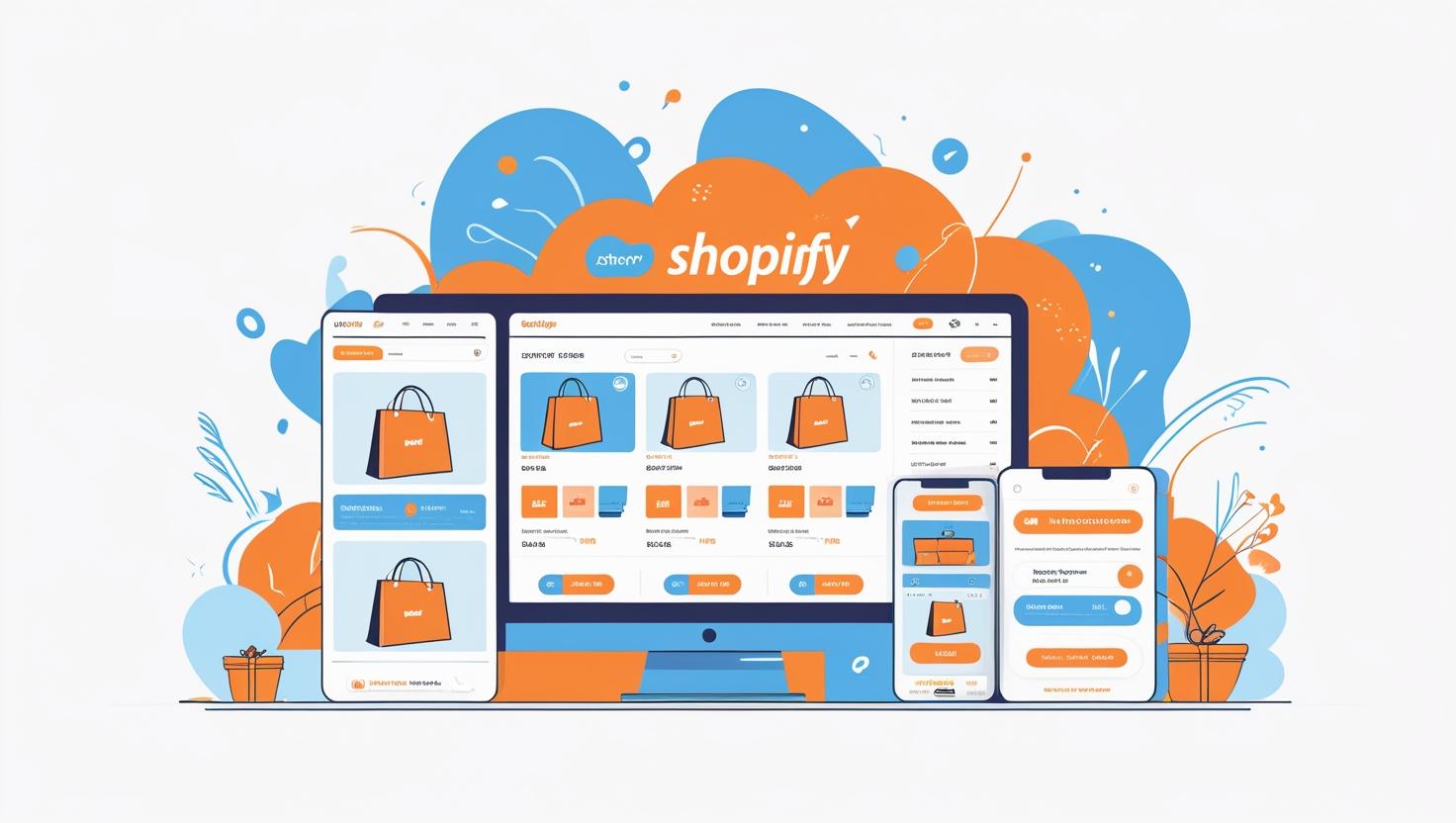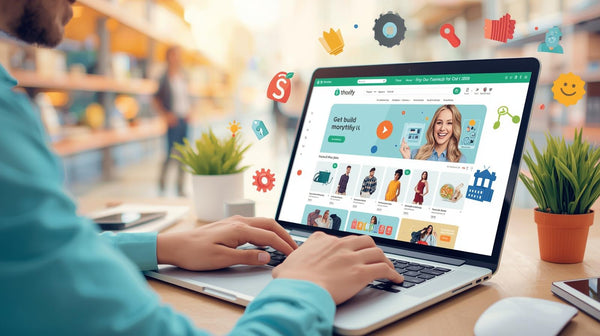Build Your Store: The Ultimate Guide for Shopify Success
Why You Should Build Your Own Store
Building your own online store is more than just putting products online it’s about creating a complete brand experience. When you control every aspect of your store, you decide how customers interact with your brand, what journey they take from landing to checkout, and how you present your products. This control gives you a competitive edge that third-party marketplaces can’t offer.
Why it matters:
-
Direct Access to Customer Data
When you sell through your own store, you get full visibility into who your customers are, what they buy, and how they behave. This data is invaluable for marketing decisions. You can segment your audience; tailor offers and predict trends something that’s often limited or unavailable on marketplaces. -
Full Control Over Branding and User Experience
Your store is your stage. You decide the look, feel, and flow of your website. From the homepage layout to checkout design, every element reflects your brand. A cohesive, professional design builds trust and encourages repeat customers, while a marketplace store feels generic and impersonal. -
Lower Fees and Higher Profit Margins
Marketplaces often take a significant cut of each sale. By building your own store, you keep more of your revenue. Even after paying for hosting, apps, or payment gateways, your profit margins are typically higher than on third-party platforms. Over time, this difference can be substantial, especially as your business grows. -
Implement Long-Term SEO Strategies
Owning your store means you can optimize it for search engines from the ground up. Unlike marketplaces, where you compete for visibility within their platform, your website can rank for keywords that matter to your audience. This drives organic traffic that doesn’t rely on ads and builds a sustainable sales channel. -
Scalability and Flexibility
With your own store, you can grow without constraints. Add new products, launch seasonal promotions, integrate apps for automation, or expand internationally. You aren’t limited by marketplace rules or algorithms that can change overnight.
In short, building your store isn’t just a technical task it’s a strategic business decision. It allows you to own your brand, control your growth, and create a customer experience that sets you apart from competitors. For any business serious about long-term success, investing in your own store is a foundational step.

Platforms to Build Your Store
When it comes to building your store, the platform you choose will shape not only how your website looks but also how it functions, grows, and ranks in search engines. Picking the right platform isn’t just a technical decision it’s a business strategy. Some platforms are beginner-friendly but limited in features, while others are robust but require technical know-how.
Popular Options for Building Your Store
-
Shopify
Shopify is the go-to choice for most entrepreneurs, and for good reason. It combines simplicity with powerful features, letting you launch a professional store quickly without sacrificing control. Its ecosystem includes themes, apps, and marketing tools, which makes scaling easier. -
WooCommerce
WooCommerce is perfect for businesses already using WordPress. It’s highly flexible and open source, giving you full control over functionality. However, it’s more technical requiring hosting, security setup, and regular updates. For those comfortable with WordPress, WooCommerce can be a strong, customizable option. -
Wix or Squarespace
These platforms are beginner-friendly, with drag-and-drop editors and beautiful templates. They’re ideal if you want a simple, visually appealing store without much technical setup. The downside is limited scalability. As your business grows, advanced features or customizations may require workarounds or even a platform switch. -
Magento
Magento is an enterprise-level platform designed for large-scale businesses with complex needs. It offers ultimate flexibility and customization but requires technical expertise and dedicated developers. For small to medium businesses, Magento often isn’t practical due to its complexity and cost.
Why Shopify Works Best for Most Businesses
-
Quick Setup: You can launch a store in days using professional templates.
-
SEO-Friendly Structure: Shopify is designed for search engines, making it easier for your store to rank organically.
-
Reliable Hosting and Security: You don’t need to worry about downtime, security breaches, or server management.
-
Integration with Payment Gateways and Apps: Shopify connects seamlessly with popular payment processors and apps for marketing, analytics, and inventory management.
Choosing the right platform is like choosing the foundation of a house. It determines how fast you can build, how flexible you can be, and how easily you can expand. For most businesses looking to balance ease of use, scalability, and SEO, Shopify provides the perfect combination.

Steps to Build Your Store
Building a store isn’t just about putting products online it’s about creating a seamless experience that attracts customers, builds trust, and drives sales. A step-by-step approach ensures your store is professional, functional, and optimized from the very beginning.
1. Define Your Niche
Before anything else, clarify your niche. Who are your ideal customers? What problems do they have, and how do your products solve them? A clear niche helps you:
-
Choose the right products to sell
-
Target marketing campaigns effectively
-
Build a brand that resonates with a specific audience
For example, instead of “clothing store,” focus on “sustainable activewear for women.” The narrower your niche, the easier it is to stand out.
2. Choose a Domain Name
Your domain is your digital address and part of your brand identity. A strong domain name should be:
-
Short and memorable
-
Easy to spell and pronounce
-
Reflective of your brand or products
Avoid overly complex names or random strings of characters. A professional domain inspires trust and makes it easier for customers to find you.
3. Select a Platform
Choosing the right platform is critical. Shopify is the most common choice because it balances ease of use, flexibility, and scalability. It handles hosting, security, and updates while giving you control over design, products, and marketing. Other platforms like WooCommerce or Wix may suit some businesses, but Shopify often provides the fastest route to a fully operational, SEO-friendly store.
4. Design Your Store
Your store design is the first impression customers get. A clean, user-friendly layout keeps visitors engaged and encourages conversions. Key design tips include:
-
Use Shopify themes optimized for speed and mobile responsiveness
-
Highlight best-selling or seasonal products on the homepage
-
Make navigation intuitive categories and filters should be easy to find
-
Maintain consistent branding with colors, fonts, and logos
Remember, your design should support user experience first, aesthetics second. A beautiful but confusing store will lose sales.
5. Add Products
Products are the heart of your store. Focus on high-quality presentation:
-
Use clear, high-resolution images showing multiple angles
-
Write detailed, benefits-focused descriptions
-
Include SEO-friendly titles and meta descriptions to improve search visibility
-
Set accurate pricing, variants, and inventory levels
This step ensures your products not only look appealing but are discoverable by search engines.
6. Set Up Payments & Shipping
A smooth checkout is essential for conversions. Choose payment gateways your customers trust and offer multiple options, including credit cards, digital wallets, and buy-now-pay-later solutions. Set up shipping with clear rates, delivery times, and tracking options to reduce cart abandonment.
7. Test Before Launch
Before going live, test your store thoroughly:
-
Check mobile responsiveness across devices
-
Verify all links, buttons, and forms work properly
-
Test checkout flow from adding a product to completing payment
-
Ensure SEO elements like titles, meta descriptions, and alt text are set
Testing reduces errors, prevents customer frustration, and ensures your store runs smoothly from day one.
Following these steps creates a store that’s not just functional but also optimized for growth, conversions, and long-term success. Skipping steps or rushing setup can cost time, money, and customer trust down the road.

Design Tips for Your Store
Design is more than just making your store look pretty. It’s a powerful tool that directly impacts customer trust, engagement, and ultimately sales. A well-designed store keeps visitors browsing, encourages purchases, and signals professionalism.
Key Design Principles
-
Clean and Uncluttered Layout
A cluttered store overwhelms visitors and makes it hard to focus on your products. Use whitespace strategically to separate sections, highlight key products, and guide customers naturally through your store. Highlight important elements like promotions, top-selling products, or call-to-action buttons without making the page feel crowded. -
Fast-Loading Pages
Page speed affects both user experience and SEO. Slow-loading pages frustrate visitors and increase bounce rates. Optimize images, limit unnecessary apps or scripts, and choose themes known for performance. Remember, a one-second delay can significantly reduce conversions, especially on mobile devices. -
Clear Navigation
Visitors should find what they’re looking for in seconds. Structure menus logically with clear categories and filters. Consider a search bar for quick access to specific products. Consistent navigation builds confidence and encourages deeper exploration of your store. -
Mobile Responsiveness
With over half of online traffic coming from smartphones, mobile optimization is no longer optional. Ensure your store adapts seamlessly to different screen sizes, buttons are easy to tap, and checkout is simple on small devices. Mobile-friendly design not only improves user experience but also boosts search engine rankings.
Pro Tips for Better Store Design
-
User Experience First, Aesthetics Second: A visually stunning site is useless if customers can’t navigate it. Focus on ease of use, speed, and accessibility before adding decorative elements.
-
Highlight Calls to Action: Make “Add to Cart” and “Buy Now” buttons prominent and consistent.
-
Visual Hierarchy Matters: Guide users’ eyes to important sections like featured products or promotions using size, color, and placement.
-
Consistent Branding: Use a cohesive color palette, typography, and imagery that reflect your brand identity. This builds recognition and trust.
Good design is the bridge between your products and your customers’ trust. A confusing or slow store will lose sales, no matter how great your products are. Investing time and thought into design ensures that visitors not only stay but convert into loyal customers.

SEO Essentials for Your Store
Search Engine Optimization, or SEO, is the engine that drives organic traffic to your store. No matter how amazing your products are, if your store isn’t visible on search engines like Google, potential customers may never find you. Investing in SEO ensures your store is discoverable, credible, and positioned for long-term growth.
Key SEO Elements
-
Keyword-Optimized Titles and Descriptions
Every product, category, and page should include keywords your customers are searching for. Use them naturally in product titles, meta descriptions, and headings. This not only helps search engines understand your content but also increases click-through rates when your listings appear in search results. -
Clean URL Structures
A clear, simple URL is both user-friendly and SEO-friendly. For example,www.yourstore.com/blue-linen-shirtis far better thanwww.yourstore.com/product?id=12345. Clean URLs make your store easier to navigate and more credible in the eyes of search engines. -
Alt Text for Images
Search engines can’t “see” images the way humans do. Alt text describes your images and helps them appear in search results for image searches. Additionally, it improves accessibility for customers using screen readers. Include descriptive, keyword-relevant alt text for all product images. -
Fast Site Speed
Page load speed directly affects rankings and user experience. Slow pages frustrate visitors and increase bounce rates, negatively impacting SEO. Optimize image sizes, reduce unnecessary scripts, and choose lightweight themes to ensure your store loads quickly on both desktop and mobile. -
Internal Linking Between Product Pages and Collections
Internal linking helps search engines understand your site structure and improves navigation for users. Linking related products, collections, and blog posts increases engagement, distributes page authority, and helps customers discover more products, ultimately boosting conversions.

Why SEO Matters
Organic traffic from search engines is one of the most cost-effective ways to attract customers. Unlike paid ads, which stop delivering results the moment your budget ends, SEO builds long-term visibility. A well-optimized store attracts consistent traffic, reduces reliance on paid advertising, and establishes credibility for your brand.
Pro Tip: SEO isn’t a one-time task it’s an ongoing strategy. Regularly update product pages, add fresh content, and monitor keyword performance to stay competitive.
Investing in SEO from the start ensures your store isn’t just functional it’s discoverable, credible, and primed for sustainable growth.
Advantages of Building Your Store
Creating your own online store is more than just putting products online. It’s about establishing a business asset that gives you independence, control, and long-term growth potential. When you build your store instead of relying on marketplaces, you unlock several key advantages.
1. Full Control
Owning your store means you control every element—from design and layout to product selection, pricing, and customer experience. You decide how products are displayed, what promotions run, and how checkout works. This level of control allows you to create a consistent, professional, and optimized experience that builds trust and encourages repeat purchases.
2. Brand Identity
A store that reflects your unique brand helps you stand out in a crowded market. You can craft a visual identity, tone of voice, and shopping experience that resonates with your audience. Unlike marketplaces, where your products compete against others in a generic format, your store tells your brand story and builds lasting connections with customers.
3. Higher Profit Margins
Marketplaces charge fees and commissions that eat into your profit. By selling through your own store, you keep more of your revenue. While there are costs like hosting, payment processing, and apps, the margins are typically higher. Over time, this difference can be significant, especially as your sales volume grows.
4. Marketing Flexibility
When you own your store, you have complete freedom over marketing. You can run email campaigns, offer discounts, implement loyalty programs, and test advertising strategies without restrictions. This flexibility lets you adapt quickly to trends, optimize campaigns, and experiment with creative ways to engage your audience.
5. Scalability
A store you own can grow with your business. You can add new products, integrate apps for automation, expand to multiple markets, and even launch new features like subscription services. There’s no platform-imposed limit on your growth, giving you freedom to evolve at your pace.

The Bigger Picture
Building your store isn’t just creating a website it’s investing in a business asset. It gives you independence from marketplace rules, strengthens your brand, and positions your business for long-term growth. Every decision, from design to marketing, is in your hands, and that control is invaluable for sustained success.
Common Challenges and How to Overcome Them
Building your store comes with incredible opportunities, but it’s not without its hurdles. Many first-time store owners underestimate how much planning and setup is involved. The good news is that most challenges can be solved or even avoided if you know what to look out for.
Common Challenges
-
Technical Setup
For beginners, setting up a store can feel overwhelming. From domains and hosting to connecting payment gateways, there are many moving parts. A misstep here can delay your launch or cause technical issues later. -
Design Decisions
Choosing the right theme and layout is harder than it sounds. Too often, store owners get stuck between making the site look “beautiful” and making it functional. Poor design choices can lead to cluttered layouts, confusing navigation, and low conversions. -
SEO and Marketing
Building a store is only half the job—getting traffic is the other half. SEO, ads, and content marketing require consistent effort. Many store owners either neglect SEO entirely or focus only on paid ads, missing out on long-term organic growth. -
Payment and Shipping Setup
Customers expect smooth, transparent checkout experiences. Errors in setting up payment gateways or unclear shipping policies can result in abandoned carts, lost trust, and lost sales.
Solutions
-
Leverage Shopify’s Guided Setup
Shopify simplifies the technical side by offering built-in hosting, SSL certificates, and payment integrations. Following its step-by-step setup helps beginners avoid many of the technical headaches that come with other platforms. -
Consult Experts for Design and SEO
If you’re unsure about design or optimization, getting expert input can save you money in the long run. A well-designed store and a solid SEO foundation prevent costly mistakes like poor conversions or low visibility. -
Start Small and Scale Gradually
Instead of uploading hundreds of products at once, start with a core selection. This makes it easier to refine product descriptions, test designs, and ensure smooth operations before expanding your catalog. -
Test Payment and Shipping Thoroughly
Before launch, place test orders to check how payments, taxes, and shipping fees appear. This ensures customers won’t encounter errors or surprises at checkout, which is one of the top reasons for abandoned carts.
The Takeaway
Every challenge is manageable if you prepare for it. By using the right tools, seeking help when needed, and starting small, you can avoid the pitfalls that frustrate so many new store owners. Being proactive not only saves time and money but also builds confidence in your store’s growth journey.

Marketing Your Store
Launching your store is a major milestone, but it’s only the beginning. A store without traffic is like a shop in the middle of the desert beautiful, well-stocked, but unseen. To succeed, you need to bring people in, build awareness, and keep customers coming back. That’s where marketing comes in.
Key Marketing Strategies
-
Social Media Advertising
Social platforms like Facebook, Instagram, and TikTok are powerful tools for reaching your target audience quickly. Paid ads let you laser-focus on demographics, interests, and behaviors. For example, if you sell fitness gear, you can run ads targeted specifically at people interested in health and wellness. The ability to reach the right people, at the right time, makes social ads one of the fastest ways to generate traffic and sales. -
Email Marketing
Email remains one of the most effective marketing channels for building loyalty and repeat purchases. With your own store, you can collect customer emails and create personalized campaigns like welcome sequences, product recommendations, or seasonal promotions. Unlike social media, where algorithms limit visibility, emails land directly in your customer’s inbox, giving you full control over your messaging. -
SEO Content Marketing
SEO isn’t just for product pages. Content marketing like blogs, buying guides, and tutorials brings in long-term traffic by answering customer questions and positioning your brand as an authority. For instance, if you sell skincare products, a blog on “Best Skincare Routines for Dry Skin” can attract organic traffic from people actively searching for solutions, who may then convert into buyers. -
Influencer Collaborations
Influencers can help you gain credibility and extend your reach to audiences that already trust them. Partnering with micro-influencers, in particular, can deliver high engagement at lower costs compared to big celebrity names. The right collaboration can put your products in front of thousands of potential customers overnight.

Pro Tip: Marketing and SEO Go Hand in Hand
Think of marketing as a balance between short-term and long-term efforts. Paid ads and influencer collaborations bring immediate traffic, while SEO and content marketing build sustainable, compounding growth. Together, they create a steady flow of new and returning customers.
The Bottom Line
Marketing your store is about visibility and connection. You’re not just selling products you’re building a community around your brand. The more consistent and diverse your marketing strategy, the more reliable your growth becomes.
Measuring Success
Launching your store is an exciting milestone, but the real work begins once customers start visiting. Growth isn’t just about having more products or running more ads, it’s about understanding what’s working and what’s not. That’s where tracking performance comes in. Data tells the story of your store, and if you know how to read it, you can make smarter, faster decisions to boost growth.
Key KPIs to Track
-
Traffic Sources and Session Counts
Knowing where your visitors come from—whether it’s Google search, social media, paid ads, or referrals—helps you invest in the right channels. For example, if most traffic is organic, doubling down on SEO makes sense. If paid ads bring in traffic but no conversions, it’s time to revisit your targeting. -
Conversion Rates
Conversion rate is the percentage of visitors who actually buy something. A low conversion rate could mean your site is getting traffic, but customers aren’t convinced to purchase. This could be due to unclear product descriptions, weak images, slow checkout, or even lack of trust signals like reviews. Improving conversion rates often brings bigger returns than simply trying to get more traffic. -
Average Order Value (AOV)
This metric shows how much customers spend on average per order. Boosting AOV can significantly increase revenue without acquiring new customers. Upselling, cross-selling, and offering bundle discounts are effective strategies to raise this number. -
Customer Retention
Getting a new customer is often more expensive than retaining an existing one. Repeat buyers not only increase revenue but also become brand advocates. Track how often customers return to purchase again. Loyalty programs, email marketing, and personalized offers can help improve retention. -
Cart Abandonment Rate
Cart abandonment happens when customers add products but don’t complete checkout. This is one of the most critical KPIs because it reveals friction points. Maybe your checkout process is too long, shipping costs are unclear, or payment options are limited. Identifying these barriers and fixing them can quickly increase sales.

Why Data Matters
Data isn’t just numbers it’s insight into customer behavior. If traffic is high but conversions are low, design or pricing may be the issue. If AOV is low, upselling could be the fix. If cart abandonment is high, simplifying checkout might solve it. Every metric gives you a roadmap for improvement.
Pro Tip: Don’t just track everything track what matters. Pick 3–5 KPIs that align with your business goals and focus on improving them.
The Takeaway
The better you understand your store’s performance, the more confidently you can make decisions. Data helps you move away from guesswork and toward strategies that actually drive growth. In short, measurement is the fuel for optimization.
Final Thoughts and Free Consultation Offer
Building your store is an investment in long-term growth, brand control, and customer loyalty. Done right, it becomes a powerful asset that generates revenue consistently.
At EcomSpiders, we handle everything for Shopify clients from store setup and design to SEO, marketing, and optimization. If you want to upgrade your store or build it right from scratch, we offer a free consultation to help you take the first step.
Your store can be more than just a website it can be a growth engine. Let’s make it happen.





0 comments